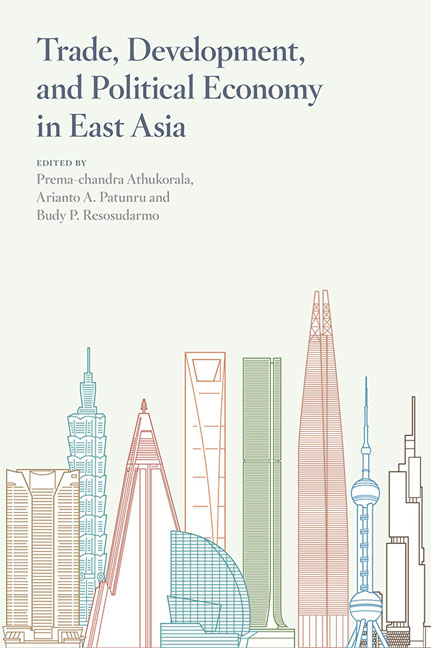Book contents
- Frontmatter
- Contents
- Tables
- Figures
- Contributors
- Foreword
- Acknowledgments
- Glossary
- 1 Introduction
- PART 1 TRADE
- PART 2 DEVELOPMENT
- 5 Economic relations between China, India and Southeast Asia: coping with threats and opportunities
- 6 Revisiting the growth acceleration episodes of Indonesia and India: a political economy reading
- 7 Exporting, education, and wage differentials between foreign multinationals and local plants in Indonesian and Malaysian manufacturing
- 8 Indonesia: returns to occupation, education, and ability during a resource export boom
- 9 Labour market regulation and employment during the Yudhoyono years in Indonesia
- 10 Vietnam: trapped on the trail of the tigers?
- PART 3 POLITICAL ECONOMY
- References
- Index
10 - Vietnam: trapped on the trail of the tigers?
from PART 2 - DEVELOPMENT
Published online by Cambridge University Press: 19 May 2017
- Frontmatter
- Contents
- Tables
- Figures
- Contributors
- Foreword
- Acknowledgments
- Glossary
- 1 Introduction
- PART 1 TRADE
- PART 2 DEVELOPMENT
- 5 Economic relations between China, India and Southeast Asia: coping with threats and opportunities
- 6 Revisiting the growth acceleration episodes of Indonesia and India: a political economy reading
- 7 Exporting, education, and wage differentials between foreign multinationals and local plants in Indonesian and Malaysian manufacturing
- 8 Indonesia: returns to occupation, education, and ability during a resource export boom
- 9 Labour market regulation and employment during the Yudhoyono years in Indonesia
- 10 Vietnam: trapped on the trail of the tigers?
- PART 3 POLITICAL ECONOMY
- References
- Index
Summary
Twenty years ago it seemed likely that Vietnam would follow the trail of the East Asian Tigers, emulating their success under the export-oriented industrialisation strategy. Conditions in Vietnam in the early 1990s were comparable to the initial conditions in Taiwan in the 1960s, Thailand in the 1970s, and China in the 1980s, when each successfully launched an export-oriented industrialisation strategy (Riedel 1993). Like those countries, Vietnam was modestly endowed with natural resources and amply endowed with human resources, with massive under- and unemployed labour in its densely populated rural sector. Like those countries at the outset of export-oriented industrialisation (EOI), industry was largely capital-intensive and state-owned. The level of industrial development in Vietnam was lower than that in the comparator countries when they launched the EOI strategy, but this could be judged an advantage for Vietnam since industrialisation under the import-substitution strategy that preceded EOI was generally inefficient. Vietnam's only disadvantage vis-à-vis its comparators was its relatively weak, practically non-existent private enterprise sector, but that was something other countries had demonstrated could be developed quickly by establishing a policy environment conducive to private investment that could draw on surplus labour in the countryside. There was no reason to doubt that Vietnam could and likely would follow the trail of its successful neighbors, possibly even surpassing their success.
In the early 1990s, Vietnam did, in fact, adopt many of the policies associated with EOI and subsequently, for about a decade, enjoyed relatively rapid growth, although not quite as rapid as the growth of the comparators during their take-off phase of EOI. Since 2006, however when Vietnam was at long last about to join the World Trade Organization (WTO), the momentum of export-oriented industrialisation dissipated and the economy entered a prolonged (and still ongoing) period of declining growth and rising macroeconomic instability (Pham and Riedel 2012).
Not surprisingly, many observers proclaim that Vietnam is stuck in the ‘middle-income trap’. The middle-income trap is routinely associated with the export-oriented industrialisation strategy which, it has been argued, leads to a dead end where prosperity is limited to the level of productivity of unskilled workers in labour-intensive manufacturing (Ketels et. al. 2010; World Bank 2010a). Calls for a new growth model and a new industrialisation strategy in Vietnam are commonplace.
- Type
- Chapter
- Information
- Trade, Development, and Political Economy in East AsiaEssays in Honour of Hal Hill, pp. 173 - 196Publisher: ISEAS–Yusof Ishak InstitutePrint publication year: 2014

